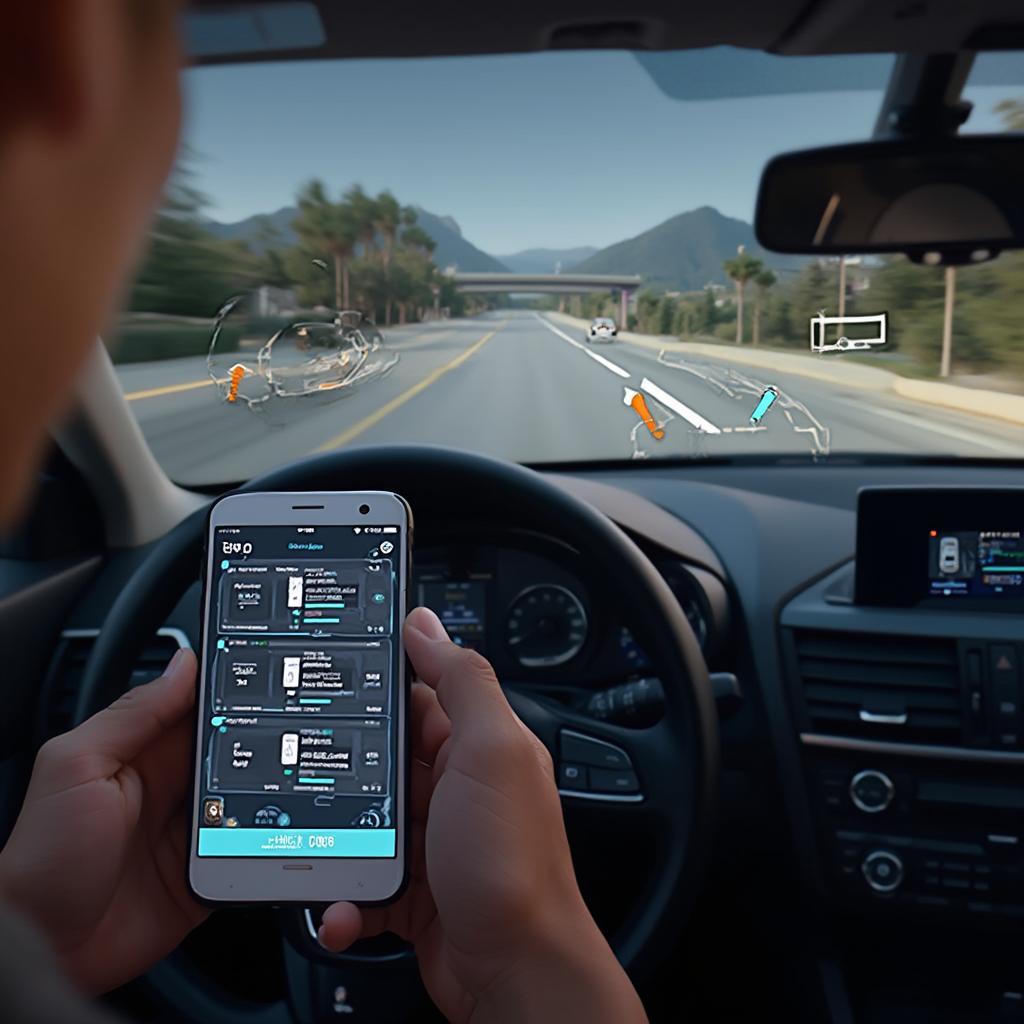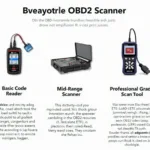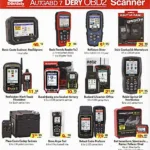A non-functional HUD OBD2 can be frustrating. This guide dives into common reasons why your HUD OBD2 might not be working and provides practical solutions to get it back up and running. We’ll cover everything from simple checks to more advanced troubleshooting techniques. Let’s get started!
Common Causes of HUD OBD2 Issues
Several factors can contribute to a malfunctioning HUD OBD2 system. Understanding these common culprits can help you pinpoint the problem quickly. Often, the issue is a simple fix, like a loose connection or incorrect settings. Other times, it might require a bit more investigation.
- Compatibility: Not all vehicles are compatible with all HUD OBD2 devices. Verify that your specific HUD model is designed to work with your car’s make and model year. Some older vehicles may not have compatible OBD2 protocols.
- Connection Problems: A loose or faulty OBD2 port connection is a frequent cause of HUD OBD2 malfunctions. Ensure the connector is securely plugged into the port and that there’s no damage to the cables or pins.
- Power Issues: Check the power supply to your HUD. If it’s powered by the cigarette lighter socket, make sure the socket is functioning correctly. Some HUDs have internal batteries that might need charging or replacing.
- Incorrect Settings: Incorrect configuration within the HUD or the accompanying app (if applicable) can lead to display issues. Review the user manual and ensure all settings are correct for your vehicle and preferences.
- Software Glitches: Sometimes, software bugs in the HUD or the connected smartphone app can cause problems. Updating the firmware on the HUD and the app to the latest versions can often resolve these issues.
After this initial overview, let’s explore relocating your OBD2 port. Sometimes, the port’s location can interfere with the HUD’s placement. Learn more about relocating obd2 port.
Troubleshooting Your HUD OBD2
If you’ve encountered a “hud obd2 not working” situation, don’t panic. Here’s a step-by-step guide to help you troubleshoot the issue:
- Check the Obvious: Start with the basics. Is the HUD turned on? Is it securely connected to the OBD2 port? Is the vehicle’s ignition turned on?
- Verify Compatibility: Double-check the compatibility of your HUD OBD2 with your vehicle. Consult the user manual or the manufacturer’s website.
- Inspect the OBD2 Port: Examine the OBD2 port for any physical damage or debris. A can of compressed air can help clean the port.
- Test with Another Vehicle: If possible, try connecting the HUD to a different compatible vehicle. This helps determine if the issue lies with the HUD itself or your car.
- Check the Fuse: Check the fuse associated with the OBD2 port in your car’s fuse box. A blown fuse could cut off power to the port.
- Reset the HUD: Many HUDs have a reset button or a reset procedure outlined in the manual. Try resetting the device to its factory defaults.
- Update Firmware and Apps: Update the HUD’s firmware and any associated smartphone apps to the latest versions.
Advanced Troubleshooting Techniques
If the basic troubleshooting steps haven’t resolved the issue, here are some more advanced techniques:
- Check OBD2 Protocol: Use an OBD2 diagnostic tool to check the protocols supported by your vehicle’s OBD2 port. Ensure the HUD supports the same protocols.
- Consult the Manufacturer: Contact the HUD manufacturer’s customer support for assistance. They may have specific troubleshooting tips or be able to diagnose a hardware problem.
- Professional Diagnosis: If all else fails, consider taking your vehicle to a qualified mechanic or auto electrician for a professional diagnosis.
For a deeper dive into OBD2 multi gauges, check out our resource on obd2 multi gauge. Understanding how these gauges work can help you understand the data your HUD is trying to access.
Why is my OBD2 HUD not displaying correctly?
Sometimes, the HUD might work but not display correctly. This could manifest as dim displays, flickering, or inaccurate information. These issues can often be attributed to incorrect settings, interference, or a faulty display unit.
- Brightness and Contrast: Adjust the HUD’s brightness and contrast settings to ensure optimal visibility in various lighting conditions.
- Reflective Film: Ensure the reflective film on the HUD’s display is clean and undamaged. A scratched or dirty film can impair visibility.
- Interference: Electronic devices or metallic objects near the HUD can sometimes cause interference. Try relocating the HUD or removing potential sources of interference.
Thinking of getting a new HUD? Explore different options on our obd2 head up display page.
Is my HUD compatible with the Torque Lite app?
Many HUD OBD2 devices are designed to work with smartphone apps like Torque Lite. This app provides enhanced functionality and data visualization. If you’re having trouble connecting your HUD to Torque Lite, ensure both devices are compatible and correctly configured. Sometimes, the issue stems from incorrect settings within the Torque Lite app itself.
“A common oversight is forgetting to enable the HUD mode within the Torque Lite app,” notes John Smith, Senior Automotive Diagnostic Technician at Smith Auto Solutions. “This simple step can often resolve connectivity issues between the HUD and the app.”
 Connecting HUD OBD2 to Torque Lite App
Connecting HUD OBD2 to Torque Lite App
You might also find helpful information about using Torque Lite with your OBD2 device at torque lite obd2 & car.
“Another frequent problem is outdated firmware on the HUD,” adds Maria Garcia, Lead Electronics Engineer at Garcia Auto Tech. “Regularly updating the firmware ensures optimal performance and compatibility with apps like Torque Lite.”
Conclusion
A malfunctioning HUD OBD2 can be a minor annoyance or a sign of a more significant issue. By following these troubleshooting tips, you can often resolve the problem quickly and get your HUD back in working order. If the problem persists, seeking professional help is always recommended. Remember to check the basics, ensure compatibility, and explore both basic and advanced troubleshooting techniques before considering a replacement. Knowing why your “hud obd2 not working” can save you time and frustration.
FAQ
- What does OBD2 stand for? OBD2 stands for On-Board Diagnostics, Generation Two.
- Can I install a HUD OBD2 myself? Yes, most HUD OBD2 devices are designed for easy self-installation.
- Where is the OBD2 port located? The OBD2 port is typically located under the dashboard, near the steering wheel.
- Do all cars have an OBD2 port? Most cars manufactured after 1996 have an OBD2 port.
- What information does a HUD OBD2 display? A HUD OBD2 can display various information such as speed, RPM, engine temperature, and fuel consumption.
- Why is my HUD OBD2 displaying blurry information? This could be due to a dirty or damaged reflective film, incorrect focus adjustment, or issues with the HUD’s projection system. Check out our article on focus issues: obd2 heads up displays are not focused at infinity.
- Can a faulty OBD2 port damage my car? A faulty OBD2 port itself is unlikely to damage your car, but underlying electrical issues might need addressing.
For further assistance, please contact us via WhatsApp: +1(641)206-8880, Email: [email protected] or visit our office at 789 Elm Street, San Francisco, CA 94102, USA. Our 24/7 customer support team is ready to help.

